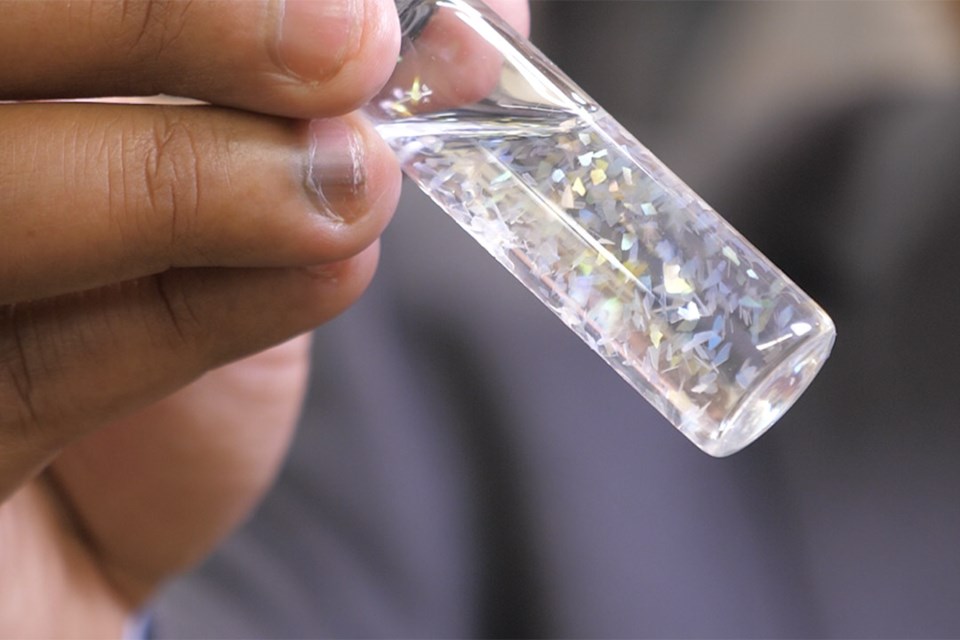SASKATOON – In everything from shiny gift wrapping to kids’ dance costumes to makeup for adults heading to parties, glitter is everywhere this time of year. But custodians and environmentalists hate the stuff, because it’s almost impossible to clean up, both indoors and especially outdoors.
Now, a University of Saskatchewan (USask) research team has developed an innovative glitter product that is biodegradable and uses light-reflecting shapes to create sparkles unlike any other – with the potential to mitigate plastic pollution around the world.
A product that is used in everything from party favours to cosmetics to boat paint, glitter products are often made of tiny plastic particles referred to as microplastics. Glitter is produced in the form of flakes, and its small size and ability to disperse into the environment in which it is released makes cleanup and control of the product difficult, if not impossible.
“In modern glitter production, aluminum and polyethylene terephthalate (microplastics) are usually combined to produce the final product,” said Amin Babaeighazvini, a PhD student in USask’s College of Engineering, and a lead member of the research team that developed the product.
“Although I have developed a number of biodegradable films over the past eight years, we have recently developed biodegradable and edible glitters from natural resources that do not include microplastics.”
Microplastics have been found to have significant effects on ecosystems when they enter waterways or other natural resources through human action, and have even been found in remote locations, far from human activity. As well as being non-biodegradable and environmentally toxic, many glitter and sparkle products contain toxic pigments that provide their colour.
These factors have led to arguments that plastic glitter should be banned from production and use.
To reduce the environmental threats of producing and using glitter, Babaeighazvini and his research supervisor Dr. Bishnu Acharya (PhD), an associate professor of engineering, have created a plant-based product called ChiralGlitter, that is inspired by the natural process of producing structural colours.
“The glitter particles are a variety of unique shapes and sizes that allow them to reflect light at different angles, causing the surface to sparkle or shimmer,” said Babaeighazvini.
This means the colours in the glitter come from light reflecting off its surface.
“Most of the colours that we see in nature are either from pigments or structural colours,” said Acharya. “Structural colour is based on how the light falls on the structure. The light reflects in a certain way, and that gives the colour. We mimic these phenomena in creating ChiralGlitter.”
ChiralGlitter is made of cellulose nanoparticles, a substance found in plant cell walls. This makes the product 100 per cent bio-based. Although the concept of biodegradable glitter is not new, the product invented by this USask research team avoids the aluminum and microplastic coatings still used often to create a sparkly surface.
“We use a biomaterial such as wood or agricultural waste to synthesize cellulose nanocrystals,” said Babaeighazvini. “Then, we fabricate functional materials from those nanocrystals, such as these biodegradable and edible glitters. The thing that makes this eco-friendly and non-toxic is the cellulose. Nanocrystals are from nature.”
As the world moves to developing more sustainable products, ChiralGlitter has the potential to be a leader in a plant-based category that can contribute to many types of commercially distributed products.
“In our lab, we always focus on how to get high-value material from something which is underutilized,” said Acharya. “And one of the applications is a bio-glitter. But the goal is always, how can we maximize the value of the underutilized biomass and create a value chain to drive the bioeconomy.”
The work was supported by Natural Science and Engineering Research Council of Canada Discovery Grant program and the Saskatchewan Ministry of Agriculture Research Chair fund through Acharya.
— Submitted by USask Media Relations




